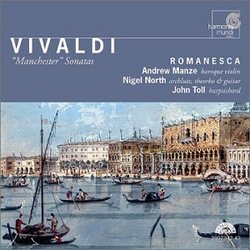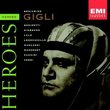| All Artists: Antonio Vivaldi, Romanesca Title: Vivaldi: Manchester Sonatas Members Wishing: 0 Total Copies: 0 Label: Harmonia Mundi Fr. Original Release Date: 1/1/2002 Re-Release Date: 9/10/2002 Album Type: Import Genre: Classical Styles: Chamber Music, Historical Periods, Baroque (c.1600-1750), Classical (c.1770-1830), Instruments, Strings Number of Discs: 2 SwapaCD Credits: 2 UPCs: 093046734220, 009304673422 |
Search - Antonio Vivaldi, Romanesca :: Vivaldi: Manchester Sonatas
CD DetailsSimilar CDs |
CD ReviewsIntoxicating Jim | 06/24/2008 (5 out of 5 stars) "For the record, the image Amazon has on display (at least as I write this) of this 2-CD set is not of the Harmonia Mundi "1+1" set that Amazon is selling. Sonatas 1-6 and 6-12 were initially released on separate CDs by Harmonia Mundi in the early 90's, and the "1+1" release brings all 12 sonatas together in a single set. (An image of the cover of the set Amazon is selling can be found in Andrew Manze's discography at the Harmonia Mundi website.) I love Manze whether he's playing Vivaldi, Handel, Bach, Biber, Corelli, etc. I find his playing intoxicating, delicious and moving, and his performance of Vivaldi's Manchester Sonatas is no exception." A surprisingly English Vivaldi Jon Chambers | Birmingham, England | 04/19/2010 (5 out of 5 stars) "Admiration for a musical work doesn't normally depend on a manuscript. Last month, however, I was given the chance to look through the set of twelve violin sonatas, in part containing Vivaldi's own corrections, housed in Manchester's Central Library. The priceless, 300 year-old volume, with its gilt-edging, leather binding and the composer's own corrections, reflects the level of craftsmanship found in the music itself.
Vivaldi's link is actually with Rome, not Manchester, for it was there that Cardinal Ottoboni accumulated the substantial number of scores that formed the private collection that would, by pure accident, eventually end up in the north-west of England. Although the manuscripts have been in England since the C18, it took the formidable scholar Michael Talbot to recognise the great importance of the slim volume when, in 1973, he realised that seven of the sonatas were unique to this particular source. They have subsequently been added to the Ryom catalogue and numbered 754-760. Listening to the sonatas in this 1993 Harmonia Mundi recording after seeing the written scores, it is easier to understand the process of converting dots into music. Although the title page (in Vivaldi's showiest calligraphy) reads Suonate a Violino e Basso per il Cembalo (ie keyboard), this recording injects extra colour - Nigel North adding to the continuo, playing archlute, theorbo and guitar. His plucked strings are a welcome feature throughout, being especially prominent in the dramatic opening to Sonata number 7 in c. Elsewhere, Andrew Manze provides his own elaborations in the slow movements, for which the scores do not write out embellishments for the repeated sections. His playing is characteristically cool (sometimes bordering on austere). And although not as technically demanding as the violin concertos, these sonatas have plenty of double-stopping and demand precision as well as imagination. As with his Handel Sonatas on the same label, Manze's playing offers what seems to be an authentically Baroque style. (Fabio Biondi's version of these sonatas provides a marked contrast in a recording that is worth consideration if you're looking for something more exuberant.) Vivaldi's Manchester Sonatas are, like his violin sonatas generally, an acquired taste. While not as immediately engaging as his concertos, they are richly rewarding to those who are prepared to give them time. And how fitting that a collection of sonatas that have their home in England and have benefited from some of Britain's finest scholarship (Talbot and Everett, above all), should have been recorded so expertly by Messrs Manze, North and Toll. Equally fitting, too, that Paul Everett - who wrote his meticulously detailed thesis on Vivaldi's Manchester collection - should have provided the liner notes." |




